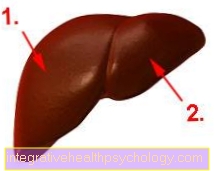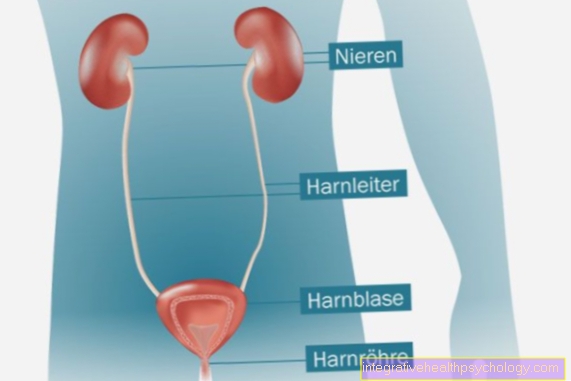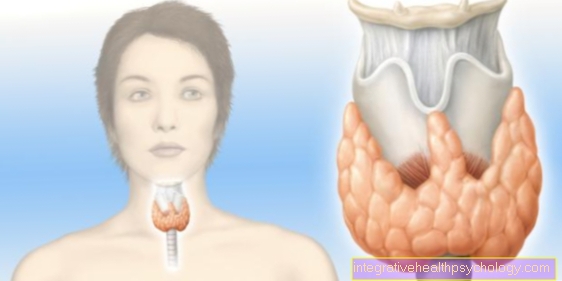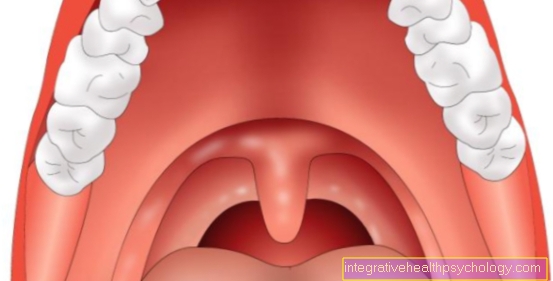Local anesthetic
General
Local anesthesia is understood to mean the temporary switching off of local nerve conduction in the body, in particular the perception of pain. This is a local anesthetic.
This is mainly used for smaller and uncomplicated operations. The local anesthetic differs significantly from narcotic drugs such as morphine, as it has neither a euphoric nor an addiction-inducing effect.
Local anesthetics achieve their effect by reversibly, i.e. not permanently, reducing the sensation of skin, muscles and the correspondingly treated organ area to such an extent that the patient does not feel any pain.
In contrast to general anesthesia, the patient remains conscious and breathes independently. Most of the time, the terms “local anesthesia” or “regional anesthesia” are used interchangeably.
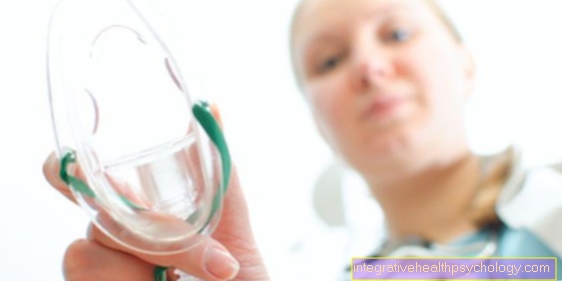
application areas
Nowadays, many surgical interventions and painful examinations are performed under local anesthesia:
- Operations on arms and legs (e.g. foot block), including shoulder and hip joints
- Superficial interventions on the skin and mucous membranes
- Dental treatments
- Obstetric measures (e.g. "Caesarean section")
- Operations on the lower abdomen (e.g. on the bladder, prostate or the genital organs)
- Operations in the anal area (e.g. hemorrhoid removal)
- Vascular surgery on the carotid artery
In addition, great successes can be achieved in pain therapy.
Local anesthetics are enjoying increasing popularity.
On the one hand, this is due to the fact that their duration of action is very short and the patient is therefore not unnecessarily burdened; on the other hand, the unproblematic treatment means that the patient can usually leave the clinic again after only a short inpatient stay, which means fewer costs for the clinics and less Circumstances arise for the patient.
Since local anesthetics, as the name suggests, only have a local effect, i.e. only in a limited place, they can only be used in certain areas and only for smaller interventions. On the one hand, local anesthetics are suitable for superficial pain inhibition. For example, the removal of birthmarks is not carried out using general anesthesia, but the patient only receives a sufficient amount of local anesthetic in the affected area to stop the pain associated with the procedure.
The treatment of hemorrhoids (painful widening of blood vessels in the area of the anus) is also carried out with the help of local anesthetics.
In addition, only one local anesthetic is used in the so-called minimally invasive procedures in order not to harm the patient unnecessarily. This includes the removal of the appendix and, in older patients, the insertion of a so-called stent into a blood vessel. Such a stent is introduced into the vascular system under local anesthesia via the common femoral artery (the large artery in the area of the thigh) and inserted into the closed vessel with the help of special imaging techniques (usually with the help of X-rays, CT or MRI images). For example, a stent can be used to widen a blood vessel in the heart that was previously very narrow. Since the operation only takes place under local anesthesia, it is also well tolerated by older patients and the patient does not have to endure unnecessarily long stays in the hospital.
So-called infiltration anesthesia is particularly popular in dentistry. A pain-relieving drug is injected into the fatty tissue with the help of a syringe. Here the local anesthetic blocks the sensitive nerves, i.e. those nerves that would normally transmit information about the origin of the pain to the brain.
Since the pain information no longer arrives in the brain, the dentist can, for example, pull the wisdom teeth or have the patient guide in pain. However, since only the pain is prevented, the patient is still fully aware of the treatment itself. Among other things, it can also lead to an uncomfortable feeling of pressure, which is not associated with pain, but still clearly shows the patient whether the tooth is already out or whether the dentist has to continue pulling.
Nevertheless, one accepts these slightly unpleasant side effects, since general anesthesia represents too high an unnecessary risk for the patient in a rather small operation.
Local anesthetics are not only used in operations. Because of its pain-relieving effect, great successes can be achieved in pain therapy. There are also gels, creams and sprays that contain a local anesthetic in low to high doses. These can be used, for example, for severe muscle pain, but also for patients with eye pain.
In addition, many patients with a strong cough and the resulting sore throat are given a low-dose local anesthetic to relieve the sore throat and thus be able to eat and speak better again.
Whether local anesthetics should also be used for itching or to relieve pain in sunburns is controversial, since in this case the local anesthetic does not address the actual problem.
In general, it is important to say that a local anesthetic only inhibits the transmission of pain. This is of course a desired effect in an operation. In the case of a sore throat, for example, the application must be viewed critically, as the cause of the sore throat must first be clarified. One should always treat the underlying disease (in this case the sore throat) first. The patient can then be prescribed a local anesthetic so that the pain does not hinder him. In addition to the areas of application already mentioned, local anesthetics are also used for cardiac arrhythmias.
Mode of action
Local anesthetics prevent information from being passed on from their place of action to the brain or spinal cord. This means that although pain occurs locally, it cannot be perceived by the brain. The reason for this is an indirect blockage of the superficial nerves, or the outer membrane of the nerve fiber and the sodium channels located there, which can perceive pain and transmit information about the pain to the brain. Action potentials cannot be formed sufficiently and the transmission of excitation is stopped. Primarily, this prevents the transmission of pain. These so-called "pain nerves" are essential because they ensure that when our hand is on a stove, we quickly withdraw them from pain. Thus, the pain nerves (so-called fast C-fibers) protect our hand from burns.
However, local anesthetics only want to switch off this effect for a short time. To do this, they have to stop the flow of information from the superficial (peripheral) nerve (neuron) into the brain. In order to understand the exact mechanism of action of the local anesthetic, one must first understand how pain can arise. Our nerve fibers consist of different parts. The transmission of pain takes place over Axons instead of which one can compare the mechanism of action with a telephone cable.
There are different channels in the axons. The sodium channel, which lets sodium ions pass, is important for the transmission of pain. These sodium ions could be compared to the dial button on the phone. As soon as the sodium ions flow into the axon, a Depolarization and the pain can be passed on from its source to the brain.
This is where the information is processed and the patient feels the pain. To make the whole thing understandable again with the telephone example: We press the selection button (sodium ions flow into the axon) and the information that we want to make a call (that we feel pain) is passed on to the telephone (the brain) through our telephone cord , only now can we talk to our call partner on the phone (only now do we feel pain).
A local anesthetic now blocks the Sodium channel. That would be as if the dial button on the phone is broken. Due to the blockage, the information can no longer be passed on.In our telephone example, this would mean that we can speak into the receiver, but our telephone partner cannot hear anything.
In humans, this means that although our skin can be injured by a doctor's cut, we cannot perceive the pain because our sodium channel is blocked and the information cannot therefore reach our brain.
variants
Surface anesthesia
Surface anesthesia is the lightest form of anesthesia and acts on the fine, sensitive nerve endings of the skin. In the context of smaller operations and punctures, e.g. in the skin or oral cavity, ointments, gels, sprays or powders reduce the perception of pain.
For example, the dentist can coat the oral mucosa with an anesthetic gel as part of the dental pain relief so that the patient no longer feels the injection of the syringe.
As a rule, the effect of the surface anesthesia wears off after a short time, but it depends on the exposure time and dosage. The most common active ingredients include lidocaine, prilocaine, benzocaine and tetracaine.
Find out more about the topic here Lidocaine as an ointment.
Spinal anesthesia
With spinal anesthesia, there is a temporary blockage of the transmission of the spinal nerve roots. To do this, an anesthetic is injected into the spinal space, also called subarachnoid space, which is filled with cerebrospinal fluid (liquor).
In adults, the spinal cord usually ends at the border between the first and second lumbar vertebrae. In order to rule out any injury, the doctor therefore never injects the anesthetic higher than between the third and fourth lumbar vertebrae. Since the spinal anesthesia still takes place near the spinal cord, it is called anesthesia near the spinal cord.
During the puncture, the person concerned usually takes a seated position and bends forward in a kind of 'cat hump'. Within a few seconds, a blockage of the conduction occurs because the anesthetic is quickly distributed in the surrounding brain water. Patients notice a tingling sensation or 'heavy' legs at the beginning, up to a rising sensation of warmth. Depending on the type of anesthetic, the type of posture and the level of the injection, the full effect of the spinal anesthesia sets in after 10-30 minutes. If a longer procedure is planned, a so-called indwelling catheter can be placed in the spinal space. Through a fine microneedle, the anesthetics continuously reach the spinal nerve root.
Spinal anesthesia is particularly suitable for operations below the navel, such as Operations on the knee joint or operations on the abdomen. Theoretically, it is possible to extend the anesthesia to regions above the navel. Such anesthesia, however, require special indications and may only be used after careful risk assessment.
Epidural anesthesia / epidural anesthesia
Unlike spinal anesthesia, epidural anesthesia uses the anesthetic in the Epidural space, also called epidural space, injected. It is located between the inner and outer layers of the hard meninges (dura mater). This method is very often used in obstetrics, for example during a caesarean section. In this context, the synonymous term epidural anesthesia or PDA is almost always used.
To achieve the same effect, compared to spinal anesthesia, a significantly higher dosage of the anesthetic to get voted. In addition, the anesthetic starts later. However, epidural anesthesia has one great advantage: It can be used in a very targeted manner, without undesirable side effects, such as the blocking of motor nerve fibers. Furthermore, the catheters can remain in the epidural space beyond the procedure without any problems. So is one long-term pain therapy also possible beyond the time of the operations. Just like spinal anesthesia, epidural anesthesia is one of the so-called spinal cord-related procedures.
Peripheral nerve block
Local anesthesia can also go beyond that Spine or the spinal cord, they are then counted among the so-called procedures remote from the spinal cord. In a peripheral nerve block, anesthetic is injected into the immediate vicinity of nerves, plexuses, or nerve trunks.
To achieve safe anesthesia, the first thing to do is to use the the exact course of the nerves under the skin to be established. For this purpose, the doctor can e.g. of striking Bone points orient which are directly related to the nerve structure sought.
These days are increasing technical means of discovery the nerves used. For example, the needle can be brought into an exact position under ultrasound control and the distribution of the anesthetic can be observed.
Another possibility is that Stimulation of the motor nerve fibers by small electrical impulses. The nerve can be so pronounced by different Muscle twitching can be localized very precisely. Overall that is Risk of Nerve Injury with the peripheral blockade extremely low.
Peripheral local anesthesia is particularly suitable for operations on the arm and shoulder. Of the Brachial plexus is a large plexus of nerves and its fibers supply almost the entire arm, as well as parts of the shoulder and chest. Since it is easy to define between the individual muscles, the Brachial plexus anesthesia take place at different points of the plexus:
- In the armpit / axillary: The simplest and most common of all plexus blocks. It is suitable for procedures on the elbow, forearm and hand.
- Interscalary: The anesthetic is placed between the two anterior scalene muscles (Mm. scaleni) injected. This type of anesthesia is preferred for surgery on the collarbone and shoulder joint.
- Supraclavicular: The injection is made over the first rib. This procedure is used less often in operations on the hand, forearm, upper arm and shoulder joint.
- Infraclavicular: The injection is made below the collarbone. It is suitable for operations on the elbow, forearm and hand.
- Of course, a peripheral nerve block can also be performed on the legs. However, the nerve plexuses are not so easy to localize there, which is why anesthesia procedures close to the spinal cord are preferred for these interventions.
Further information can also be found at peripheral nerve block.
Intravenous regional anesthesia
In contrast to the other local anesthesia, the anesthetic is administered directly into the vein. It is particularly suitable for shorter and uncomplicated interventions. The blood vessels are temporarily tied off so that the blood supply to the affected arm or leg is interrupted. By means of a tightly applied Blood pressure cuff the vessels remain bloodless even during the operation. The anesthetic is then injected into the affected vein and works until the cuff is removed.
Intravenous regional anesthesia is a particularly simple and safe method of anesthesia. However, many patients describe the prolonged congestion of the blood vessels as very uncomfortable.
Side effects
In general, the side effects of local anesthetics are very minor compared to the side effects of general anesthesia.
However, it is important to note that local anesthetics are different from the cocaine and therefore on the one hand have a certain (albeit minimal) potential for addiction and on the other hand can have certain side effects. This includes above all heart problems.
The heart may beat slower (Bradycardia), At the same time, some patients have an increasingly faster and irregular heartbeat (Tachycardia). So in general it can too Cardiac arrhythmias come and problems with the heart conduction.
In some patients it may be in addition to Convulsions and Impaired consciousness up to Faint come. Also, some patients show strong allergic reactionthat of itching over Vomit can lead to a state of shock. It is therefore important to watch out for any symptoms after treatment with a local anesthetic and to inform a doctor if the symptoms worsen.
Contraindications
There are several contraindications for which patients should not receive local anesthetics. The reason for this is mostly the fact that local anesthetics are often used adrenaline because adrenaline ensures that the blood vessels constrict and that not so much blood comes into the area where the local anesthetic is effective. Of course, this is very desirable for smaller operations because you want to avoid unnecessary blood flow here.
Patient with known allergic reactions or Heart problems However, you should not be given any local anesthetics, otherwise the problems can worsen.
In addition, local anesthetics should never be used in the area of the fingers, toes, nose or in the area of the penis, otherwise the blood flow can be reduced so much that parts of the tissue die.
Advantages and disadvantages
Compared to conventional general anesthesia, local anesthesia offers numerous advantages. The human body is significantly less stressed because of the anesthetic not on the entire cycle, but only acts on the desired nerve pathways, i.e. locally limited.
Unpredictable events such as a heart attack, or stroke postoperative bowel paralysis, much less frequently. Typical ventilation errors can almost be ruled out with local anesthesia, as the patients breathe independently. Serious side effects of general anesthesia, such as the danger of malignant hyperthermia can hardly be observed. also Patients recover much faster after local anesthesia: You are allowed to leave the recovery room after a short period of time, require less complex monitoring and can get up independently much earlier.
However, there are also disadvantages and risks with local anesthesia. You need e.g. one significantly higher expenditure of time. Especially with anesthesia close to the spinal cord, it can take some time between the correct injection and the complete anesthesia. So when it has to be quick and it is one emergency general anesthesia is often the better choice. In addition, the success depends heavily on the skill, experience and ability of the doctor. An incorrectly set needle may cause a incomplete anesthesia have as a consequence.
For many anxious or insecure patients, the thought of experiencing a surgical procedure with full consciousness is rather daunting. That is why it is very important to have a sensitive discussion before the operation. In the conversation, the doctor should have the describe the exact process and the patient e.g. prepare for any noises that may occur. Those affected often receive a before the procedure light sedative. They are conscious during the operation, but can often no longer remember the operation at all or only incompletely, or even 'oversleep' it.
















